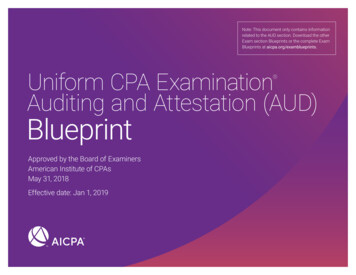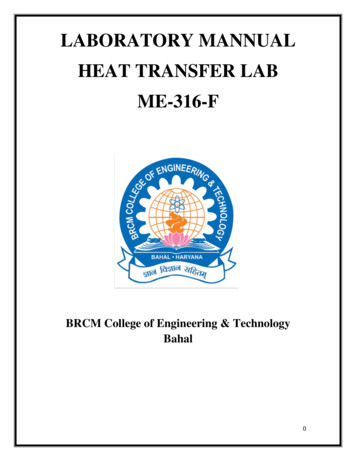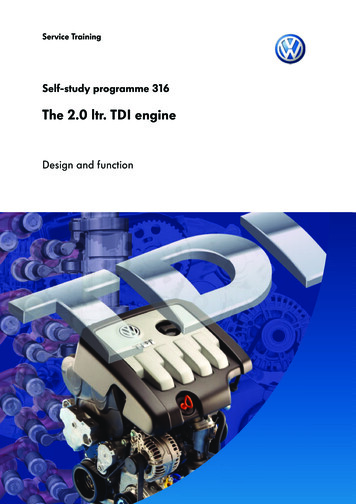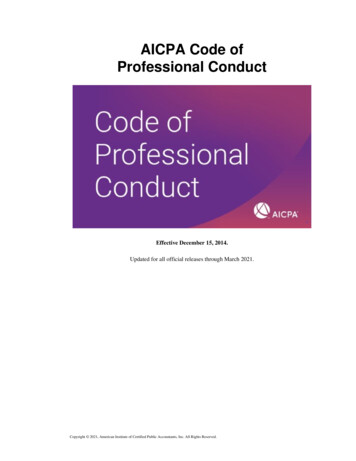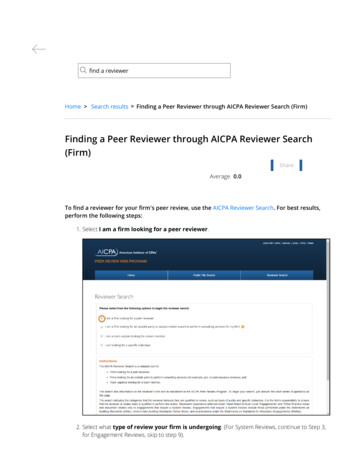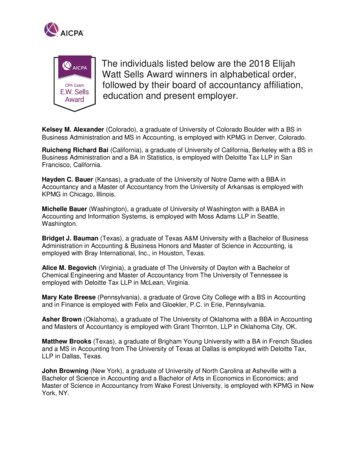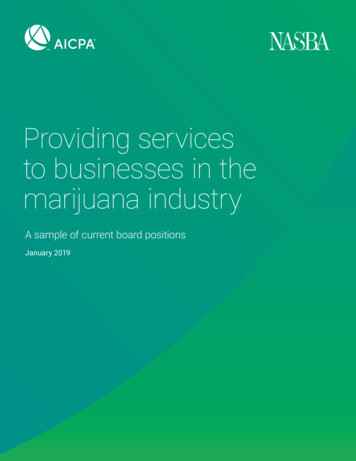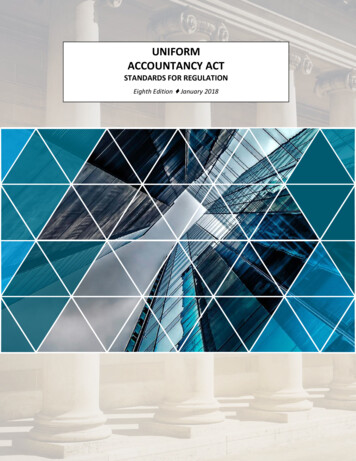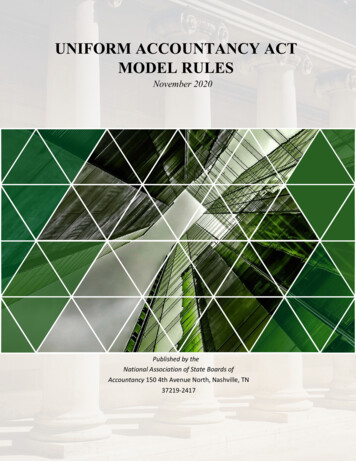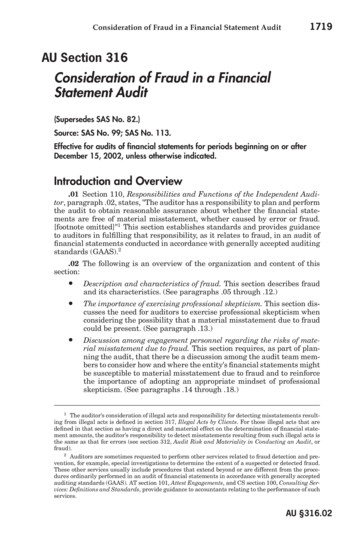
Transcription
1719Consideration of Fraud in a Financial Statement AuditAU Section 316Consideration of Fraud in a FinancialStatement Audit(Supersedes SAS No. 82.)Source: SAS No. 99; SAS No. 113.Effective for audits of financial statements for periods beginning on or afterDecember 15, 2002, unless otherwise indicated.Introduction and Overview.01 Section 110, Responsibilities and Functions of the Independent Auditor, paragraph .02, states, "The auditor has a responsibility to plan and performthe audit to obtain reasonable assurance about whether the financial statements are free of material misstatement, whether caused by error or fraud.[footnote omitted]"1 This section establishes standards and provides guidanceto auditors in fulfilling that responsibility, as it relates to fraud, in an audit offinancial statements conducted in accordance with generally accepted auditingstandards (GAAS).2.02 The following is an overview of the organization and content of thissection: Description and characteristics of fraud. This section describes fraudand its characteristics. (See paragraphs .05 through .12.) The importance of exercising professional skepticism. This section discusses the need for auditors to exercise professional skepticism whenconsidering the possibility that a material misstatement due to fraudcould be present. (See paragraph .13.) Discussion among engagement personnel regarding the risks of material misstatement due to fraud. This section requires, as part of planning the audit, that there be a discussion among the audit team members to consider how and where the entity's financial statements mightbe susceptible to material misstatement due to fraud and to reinforcethe importance of adopting an appropriate mindset of professionalskepticism. (See paragraphs .14 through .18.)1The auditor's consideration of illegal acts and responsibility for detecting misstatements resulting from illegal acts is defined in section 317, Illegal Acts by Clients. For those illegal acts that aredefined in that section as having a direct and material effect on the determination of financial statement amounts, the auditor's responsibility to detect misstatements resulting from such illegal acts isthe same as that for errors (see section 312, Audit Risk and Materiality in Conducting an Audit, orfraud).2Auditors are sometimes requested to perform other services related to fraud detection and prevention, for example, special investigations to determine the extent of a suspected or detected fraud.These other services usually include procedures that extend beyond or are different from the procedures ordinarily performed in an audit of financial statements in accordance with generally acceptedauditing standards (GAAS). AT section 101, Attest Engagements, and CS section 100, Consulting Services: Definitions and Standards, provide guidance to accountants relating to the performance of suchservices.AU §316.02
1720The Standards of Field Work Obtaining the information needed to identify risks of material misstatement due to fraud. This section requires the auditor to gatherinformation necessary to identify risks of material misstatement dueto fraud, bya. Inquiring of management and others within the entity about therisks of fraud. (See paragraphs .20 through .27.)b. Considering the results of the analytical procedures performed inplanning the audit. (See paragraphs .28 through .30.)c. Considering fraud risk factors. (See paragraphs .31 through .33,and the Appendix, "Examples of Fraud Risk Factors" [paragraph .85].)d. Considering certain other information. (See paragraph .34.) Identifying risks that may result in a material misstatement due tofraud. This section requires the auditor to use the information gathered to identify risks that may result in a material misstatement dueto fraud. (See paragraphs .35 through .42.) Assessing the identified risks after taking into account an evaluation ofthe entity's programs and controls. This section requires the auditor toevaluate the entity's programs and controls that address the identifiedrisks of material misstatement due to fraud, and to assess the riskstaking into account this evaluation. (See paragraphs .43 through .45.) Responding to the results of the assessment. This section emphasizesthat the auditor's response to the risks of material misstatement dueto fraud involves the application of professional skepticism when gathering and evaluating audit evidence. (See paragraph .46 through .49.)The section requires the auditor to respond to the results of the riskassessment in three ways:a. A response that has an overall effect on how the audit is conducted, that is, a response involving more general considerationsapart from the specific procedures otherwise planned. (See paragraph .50.)b. A response to identified risks that involves the nature, timing,and extent of the auditing procedures to be performed. (See paragraphs .51 through .56.)c. A response involving the performance of certain procedures tofurther address the risk of material misstatement due to fraudinvolving management override of controls. (See paragraphs .57through .67.)Evaluating audit evidence. This section requires the auditor to assessthe risks of material misstatement due to fraud throughout the auditand to evaluate at the completion of the audit whether the accumulated results of auditing procedures and other observations affect theassessment. (See paragraphs .68 through .74.) It also requires the auditor to consider whether identified misstatements may be indicativeof fraud and, if so, directs the auditor to evaluate their implications.(See paragraphs .75 through .78.)Communicating about fraud to management, those charged with governance, and others. This section provides guidance regarding the auditor's communications about fraud to management, those charged withgovernance, and others. (See paragraphs .79 through .82.) Documenting the auditor's consideration of fraud. This section describes related documentation requirements. (See paragraph .83.)AU §316.02
Consideration of Fraud in a Financial Statement Audit1721[Revised, April 2007, to reflect conforming changes necessary due to the issuance of Statement on Auditing Standards No. 114.].03 The requirements and guidance set forth in this section are intendedto be integrated into an overall audit process, in a logical manner that is consistent with the requirements and guidance provided in other sections, includingsection 311, Planning and Supervision; section 312, Audit Risk and Materialityin Conducting an Audit; section 314, Understanding the Entity and Its Environment and Assessing the Risks of Material Misstatement, and section 318Performing Audit Procedures in Response to Assessed Risks and Evaluating theAudit Evidence Obtained. Even though some requirements and guidance setforth in this section are presented in a manner that suggests a sequential auditprocess, auditing in fact involves a continuous process of gathering, updating,and analyzing information throughout the audit. Accordingly the sequence ofthe requirements and guidance in this section may be implemented differentlyamong audit engagements. [Revised, March 2006, to reflect conforming changesnecessary due to the issuance of Statements on Auditing Standards No. 109 andNo. 110.].04 Although this section focuses on the auditor's consideration of fraudin an audit of financial statements, it is management's responsibility to design and implement programs and controls to prevent, deter, and detect fraud.3That responsibility is described in section 110.03, which states, "Managementis responsible for adopting sound accounting policies and for establishing andmaintaining internal control that will, among other things, authorize, record,process, and report transactions (as well as events and conditions) consistentwith management's assertions embodied in the financial statements." Management, along with those charged with governance, should set the proper tone;create and maintain a culture of honesty and high ethical standards; and establish appropriate controls to prevent, deter, and detect fraud. When managementand those charged with governance fulfill those responsibilities, the opportunities to commit fraud can be reduced significantly. [Revised, March 2006, toreflect conforming changes necessary due to the issuance of Statement on Auditing Standards No. 106. Revised, April 2007, to reflect conforming changesnecessary due to the issuance of Statement on Auditing Standards No. 114.]Description and Characteristics of Fraud.05 Fraud is a broad legal concept and auditors do not make legal determinations of whether fraud has occurred. Rather, the auditor's interest specifically relates to acts that result in a material misstatement of the financialstatements. The primary factor that distinguishes fraud from error is whetherthe underlying action that results in the misstatement of the financial statements is intentional or unintentional. For purposes of the section, fraud is anintentional act that results in a material misstatement in financial statementsthat are the subject of an audit.43In its October 1987 report, the National Commission on Fraudulent Financial Reporting, alsoknown as the Treadway Commission, noted, "The responsibility for reliable financial reporting residesfirst and foremost at the corporate level. Top management, starting with the chief executive officer,sets the tone and establishes the financial reporting environment. Therefore, reducing the risk offraudulent financial reporting must start with the reporting company."4Intent is often difficult to determine, particularly in matters involving accounting estimatesand the application of accounting principles. For example, unreasonable accounting estimates maybe unintentional or may be the result of an intentional attempt to misstate the financial statements.Although an audit is not designed to determine intent, the auditor has a responsibility to plan andperform the audit to obtain reasonable assurance about whether the financial statements are free ofmaterial misstatement, whether the misstatement is intentional or not.AU §316.05
1722The Standards of Field Work.06 Two types of misstatements are relevant to the auditor's consideration of fraud—misstatements arising from fraudulent financial reporting andmisstatements arising from misappropriation of assets. Misstatements arising from fraudulent financial reporting are intentional misstatements or omissions of amounts or disclosures in financial statements designed to deceive financial statement users wherethe effect causes the financial statements not to be presented, in all material respects, in conformity with generally accepted accounting principles (GAAP).5 Fraudulent financial reporting may be accomplishedby the following:— Manipulation, falsification, or alteration of accounting records orsupporting documents from which financial statements are prepared— Misrepresentation in or intentional omission from the financialstatements of events, transactions, or other significant information— Intentional misapplication of accounting principles relating toamounts, classification, manner of presentation, or disclosureFraudulent financial reporting need not be the result of a grand planor conspiracy. It may be that management representatives rationalizethe appropriateness of a material misstatement, for example, as an aggressive rather than indefensible interpretation of complex accountingrules, or as a temporary misstatement of financial statements, including interim statements, expected to be corrected later when operationalresults improve. Misstatements arising from misappropriation of assets (sometimes referred to as theft or defalcation) involve the theft of an entity's assetswhere the effect of the theft causes the financial statements not to bepresented, in all material respects, in conformity with GAAP. Misappropriation of assets can be accomplished in various ways, includingembezzling receipts, stealing assets, or causing an entity to pay forgoods or services that have not been received. Misappropriation of assets may be accompanied by false or misleading records or documents,possibly created by circumventing controls. The scope of this sectionincludes only those misappropriations of assets for which the effect ofthe misappropriation causes the financial statements not to be fairlypresented, in all material respects, in conformity with GAAP.07 Three conditions generally are present when fraud occurs. First, management or other employees have an incentive or are under pressure, whichprovides a reason to commit fraud. Second, circumstances exist—for example,the absence of controls, ineffective controls, or the ability of management tooverride controls—that provide an opportunity for a fraud to be perpetrated.Third, those involved are able to rationalize committing a fraudulent act. Someindividuals possess an attitude, character, or set of ethical values that allowthem to knowingly and intentionally commit a dishonest act. However, evenotherwise honest individuals can commit fraud in an environment that imposes sufficient pressure on them. The greater the incentive or pressure, themore likely an individual will be able to rationalize the acceptability of committing fraud.5Reference to generally accepted accounting principles (GAAP) includes, where applicable, acomprehensive basis of accounting other than GAAP as defined in section 623, Special Reports, paragraph .04.AU §316.06
Consideration of Fraud in a Financial Statement Audit1723.08 Management has a unique ability to perpetrate fraud because it frequently is in a position to directly or indirectly manipulate accounting recordsand present fraudulent financial information. Fraudulent financial reportingoften involves management override of controls that otherwise may appear to beoperating effectively.6 Management can either direct employees to perpetratefraud or s
.07 Three conditions generally are present when fraud occurs. First, man-agement or other employees have an incentive or are under pressure, which provides a reason to commit fraud. Second, circumstances exist—for example, the absence of controls, ineffective controls, or File Size: 201KBPage Count: 52
